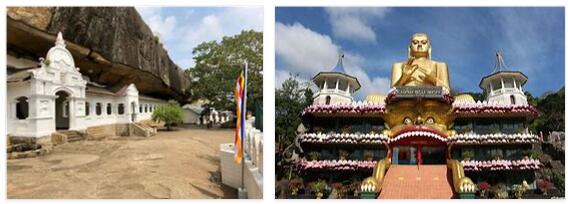Golden Rock Temple of Dambulla (World Heritage)
Dambulla has been an important Buddhist pilgrimage site for more than 2000 years. It has exceptionally well-preserved cave temples with over 150 Buddha statues and unique Buddhist wall paintings on an area of over 2300 m². Highlights are the “Gods-King Cave” with the 14 m long reclining Buddha and the “Cave of the Great Kings” with a blessing Buddha.
Dambulla Golden Rock Temple: Facts
| Official title: | Golden Rock Temple of Dambulla |
| Cultural monument: | in a gneiss rock five cave temples with Buddhist wall paintings on an area of 2326 m² as well as 157 Buddha statues, among others. “Divine King’s Cave” (Devarajalena) with a reclining Buddha filling the cave and the 48 m long and 15 m wide “Cave of the Great Kings” (Maharajalena) with a blessing Buddha, the wooden figures of the Bodhisattvas Maitreya and Avalokiteshvara and the images of the kings Vattagamini Abhaya and Nissankamalla as well as “Great New Temple” (Maha Alut Vihara) with the statue of the Kandy King Kirti Sri Rajasingha |
| Continent: | Asia |
| Country: | Sri Lanka |
| Location: | Dambulla, between Kandy and Anuradhapura |
| Appointment: | 1991 |
| Meaning: | An important pilgrimage site for more than 2000 years and the best preserved cave temple complex in Sri Lanka with Buddhist wall paintings |
Golden Rock Temple of Dambulla: History
| 103 BC Chr. | Incursion of the South Indian Panca Dravides |
| 100 BC Chr. | proven origin |
| 11./12. Century | first phase of design |
| 1187-96 | King Kirti Sri Nissankamalla |
| 18./19. Century | second phase of the design |
| 1747-81 | Kandy King Kirti Sri Rajasingha, the innovator of Buddhism |
Under the eyes of the Buddha
It takes a few seconds for the eyes to get used to the darkness and for the matt gold to become visible in the glow of weak light sources. The skin signals pleasant coolness, the nose perceives slightly musty cave air: first fleeting impressions when entering the rock temple. Seconds later they appear in all their glory like mystical greetings from bygone times: a larger than life, peacefully reclining Buddha, gold-shining Buddha statues in a lotus position and rock vaults artfully covered with tempera paintings. It seems as if one has suddenly entered the treasury of a palace through a secret door.
It is believed that it was King Nissankamalla in the 12th century who had the remains of the first temple from the second or third century BC restored and transformed into today’s beauty. In times of war, kings are said to have found refuge here again and again. According to tradition, coronation ceremonies were even held in the Dambulla caves.
Most of the tempera paintings that cover the “sky” of the caves are believed to be around a thousand years old in their current appearance. The opinions of experts on the age of the individual frescoes, which also show scenes from the life of Buddha – from the dream of the Mahamaya to the temptation by the demon Mara – nevertheless differ. Some experts assume that the most colorful tones were only applied at the beginning of the 20th century. Nevertheless, they too date the oldest surviving frescoes at least half a millennium into the past.
In the first cave you come across the largest Buddha statue of the temple complex with a length of 14 meters. The founder of the religion rests here under the watchful eyes of his student Ananda with his eyes closed. The adjoining cave contains standing and seated Buddha statues, images of Hindu deities such as Saman and Upulvan, a Sinhala king who hid for a few years with the monks of Dambulla from the invaded South Indian Panca-Dravidae. The approximately seven meter high ceiling is decorated over and over with images of Buddha. In a large bowl, water is collected that drips from the cave ceiling – allegedly the cool water of an underground river that, according to legend, flows uphill, which does not dry up even in the dry season.
In Dambulla, strict attention is paid to the appropriate demeanor of visitors: no uncovered shoulders, no tourist legs wedged into shorts. But just in case you are prepared, as the strict temple guards have toga-like strips of fabric in subtle shades to cover unseemly nakedness.
Before you can find your inner peace in the Golden Rock Temple, you climb the long stairs to a height of around 122 meters. Particularly intrusive are the numerous monkeys who frolic on the stairs to the temple entrance and are notorious for stealing everything that is small and handy or that could be nutritious. Outside the sanctuary, traders and snake charmers have gathered, who every day hope for wealthy customers, because Dambulla is one of the tourist highlights of a trip to Sri Lanka according to equzhou. Buddha seems omnipresent: you can feel this on the drive to Dambulla as well as on short taxi tours across the island. Again and again you see cars stopping in front of temples with their engines running. Drivers quickly jump out of their car and pause, if only for a few seconds, in devotion. sacrifice a coconut or donate a few rupees to get back on the road as soon as possible. “A prayer,” says taxi driver Chandra, “is a must. After all, everyone wants to be well protected on the go. ”If, for once, there is no Buddhist shrine in the immediate vicinity, a short prayer is said in a church or in a Hindu temple. This is also an expression of other religions that are tolerant of Buddhism.




